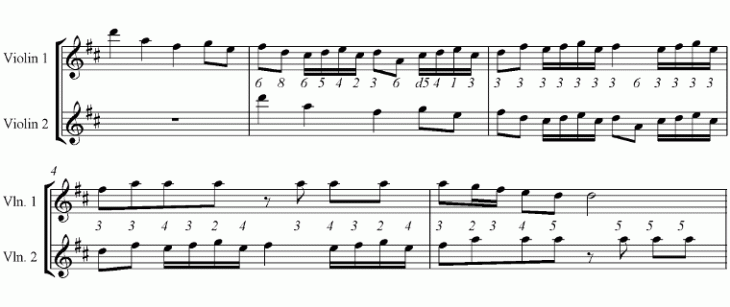- Counterpoint Tutorials -
The Contrapuntal Skeleton - Fifth Species
This is the final lesson in Fux's series on how to write counterpoint. It is, without question, the most difficult species to understand and master, as it is the species with the fewest restrictions. Essentially, fifth species counterpoint is a combination of all the previous lessons, along with more permissible dissonances and no restrictions as to what rhythmic values are allowed.
Wait - so you're telling me I can do anything I want?
Pretty much. Just remember that counterpoint tries to help a composer write music in a very specific style, and your counterpoint will be most successful if you try to emulate and understand that style. Listening to the contrapuntal masters of the 14th and 15th century (Machaut and Josquin de Prez comes to mind) will help you go far in your fifth species counterpoint.
Rules for Fifth Species
- You may use constructs from any of the previous species.
- All rhythmic values are permitted, but in the interests of practicality and the writing of period music, it is stressed that one use note values no smaller than a sixteenth note.
- All rules involving the treatment of perfect intervals are still in effect! No hidden perfect intervals, and no perfect intervals approached by similar motion!
- You may use any previously discussed dissonance. You may also use rhythmic augmentations and diminutions of these dissonances.
- You are now allowed to use retardations and cambiata, although the mechanics of these dissonances are best left to a later lesson.
- More adventurous composers can attempt to combine the functions of multiple dissonances together - but do so sparingly.
Because this level of counterpoint is so open-ended, we'll have to take a more gradual approach to understanding this species. Let's start with something simple - we'll start off with increasing the rhythmic values to that of an eighth note, and then we'll examine the intervals, just as we did before with quarter notes and third species.
Fifth Species, with the rhythmic value of an eighth note
Click here to listen!
Let us, for a moment, forget about the consecutive dissonances found in the 4th measure, and instead look at the treatment of perfect intervals. Even though these parts are so close together, they retain their individuality - you can distinctly hear two lines at all times. This is, in part, achieved by his perfect interval treatment. All perfect intervals in this piece are either approached by contrary motion, or by oblique motion.
Telemann also seems to be doing crazy things with his dissonances. Consecutive dissonances are very rare in strict 16th century renaissance counterpoint, only really used in particular embellishments and dissonance types. Why would Telemann write so much dissonance? Perhaps it has to do with the voice the dissonance is moving against. Also remember that Telemann wrote during the wane of modality and the strict contrapuntal style, and in the rise of the baroque.
Examine the worst offenders: the intervals in the fourth measure reading 3-4-2 happen against what could be described as a pedal tone - that repeated high A. Does the fact that the dissonance happens against a repeated note excuse the fact that we're hearing a 4th followed by a 2nd, and, for that matter, a 2nd on the strong part of the beat? Let's see if allowing 16th notes makes this more sensible.
Telemann also seems to be doing crazy things with his dissonances. Consecutive dissonances are very rare in strict 16th century renaissance counterpoint, only really used in particular embellishments and dissonance types. Why would Telemann write so much dissonance? Perhaps it has to do with the voice the dissonance is moving against. Also remember that Telemann wrote during the wane of modality and the strict contrapuntal style, and in the rise of the baroque.
Examine the worst offenders: the intervals in the fourth measure reading 3-4-2 happen against what could be described as a pedal tone - that repeated high A. Does the fact that the dissonance happens against a repeated note excuse the fact that we're hearing a 4th followed by a 2nd, and, for that matter, a 2nd on the strong part of the beat? Let's see if allowing 16th notes makes this more sensible.
Fifth Species, with the rhythmic value of a sixteenth note
Click here to listen!
It's virtually identical to the original - only the tiny thirty-second note embellishments are removed.
This canon by Telemann seems to be most focused on embellishing the counterpoint on the rhythmic level of the quarter note. Examine the "upward-step upward-step upward-step downward-leap pattern" first seen in the second beat of the second measure. This pattern recurs over and over in the piece, without regard to the sorts of dissonances it creates with the other part. The strong beats always carry consonances, despite some dissonant intervals found on strong parts of the beat.
Look again at the contour of the piece. The foundation that we laid during the first species counterpoint lesson makes such an impact on our piece now. We descend from a high register and the parts intermingle, diverging slightly at the end.
This canon by Telemann seems to be most focused on embellishing the counterpoint on the rhythmic level of the quarter note. Examine the "upward-step upward-step upward-step downward-leap pattern" first seen in the second beat of the second measure. This pattern recurs over and over in the piece, without regard to the sorts of dissonances it creates with the other part. The strong beats always carry consonances, despite some dissonant intervals found on strong parts of the beat.
Look again at the contour of the piece. The foundation that we laid during the first species counterpoint lesson makes such an impact on our piece now. We descend from a high register and the parts intermingle, diverging slightly at the end.


